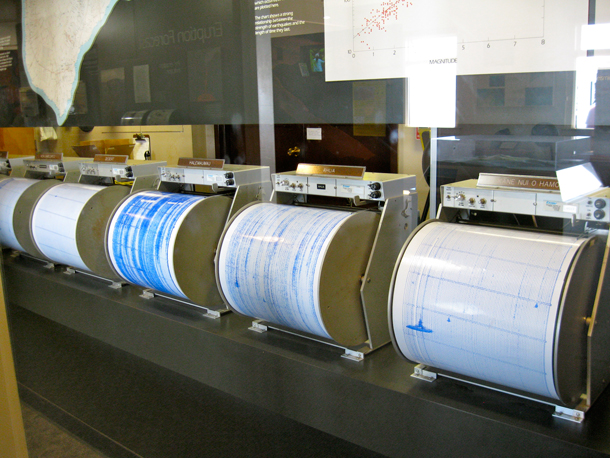Note on Emerging Science: The Days the Earth Stood Still
Air Date: Week of May 1, 2020

The earth is always vibrating, as small amplitude waves ripple across its surface and rattle up from below. (Photo: Ashok Boghani, Flickr, CC BY-NC 2.0)
As people around the world self-isolate and non-essential work is put on hold, the Earth has grown quieter. Seismographic data show that ambient vibrations caused by human activities, have decreased by 30 to 50% since stay-at-home orders went into effect. Living on Earth’s Isaac Merson reports.
Transcript
CURWOOD: Just ahead, many zoos and aquariums have had to close their doors but they’ve opened an online window. But first this note on emerging science from Isaac Merson.
[SCIENCE NOTE THEME]
MERSON: As people around the globe shelter at home, an unusual calm has come to the surface of the earth.
In fact, our reduced activity and physical movement can actually be measured using seismographs, instruments used to measure the minute movements of the earth beneath our feet.
Seismographs are extremely sensitive. They sense vibrations caused by sources as varied as the wind moving across the surface of the earth, the crash of waves on the shore, the hum of pressure as gasses bubble up through cracks and seams in the crust in the earth.
And they also detect vibrations caused by human activities, such as the movement of vehicles or the pounding of industrial machinery.
[MACHINERY SOUND]

Seismographs are incredibly sensitive instruments, and can detect vibrations from sources as minute as the wind blowing across the surface of the earth. The seismograph showing all the blue ink indicates lots of vibration, which is coming from the crater rim of Hawaii’s Halema‘uma‘u Crater. (Photo: Rosa Say, Flickr, CC BY-NC-ND 2.0)
All these vibrations create a background which can be hard for earth scientists to tease apart.
But in the weeks since governments have issued orders to stay at home Seismograph data from around the world has shown a tremendous decrease in the amount of these ambient seismic vibrations.
One seismograph located at the Royal Observatory of Belgium showed a greater than 30% decrease in the total background vibrations in the weeks since Belgium instructed its citizens to stay home.
And Brussels isn’t alone. Seismographs from Los Angeles, London, and Barcelona have shown similar or even larger reductions.
Now, in the absence of some of that muddy background data, scientists may be able to gather important information about the influence of other sources of ambient vibrations, such as the exact contribution of the oceans.
[OCEAN SOUNDS]
This may help us better predict future earthquake events, especially in highly populated urban areas.
Update this morning: anthropogenic noise is still low. We also compare the median noise per weekday/hour before/after lockdown! #staysafe #stayhomebelgium pic.twitter.com/iAE1imBuEj
— Seismologie.be (@Seismologie_be) April 6, 2020
In the meantime, the relative stillness of the earth’s crust could allow seismologists to better detect seismic events happening right now,
[EARTHQUAKE SOUND]
as the signal may come through more clearly with less competing noise, like a radio signal with less static.
For Living on Earth, I’m Isaac Merson.
[SCIENCE NOTE THEME]
Links
Nature News | “Coronavirus lockdowns have changed the way Earth moves”
Follow @Seismologie_be to see current seismograph data from the Royal Observatory of Belgium
Living on Earth wants to hear from you!
Living on Earth
62 Calef Highway, Suite 212
Lee, NH 03861
Telephone: 617-287-4121
E-mail: comments@loe.org
Newsletter [Click here]
Donate to Living on Earth!
Living on Earth is an independent media program and relies entirely on contributions from listeners and institutions supporting public service. Please donate now to preserve an independent environmental voice.
NewsletterLiving on Earth offers a weekly delivery of the show's rundown to your mailbox. Sign up for our newsletter today!
 Sailors For The Sea: Be the change you want to sea.
Sailors For The Sea: Be the change you want to sea.
 The Grantham Foundation for the Protection of the Environment: Committed to protecting and improving the health of the global environment.
The Grantham Foundation for the Protection of the Environment: Committed to protecting and improving the health of the global environment.
 Contribute to Living on Earth and receive, as our gift to you, an archival print of one of Mark Seth Lender's extraordinary wildlife photographs. Follow the link to see Mark's current collection of photographs.
Contribute to Living on Earth and receive, as our gift to you, an archival print of one of Mark Seth Lender's extraordinary wildlife photographs. Follow the link to see Mark's current collection of photographs.
 Buy a signed copy of Mark Seth Lender's book Smeagull the Seagull & support Living on Earth
Buy a signed copy of Mark Seth Lender's book Smeagull the Seagull & support Living on Earth

